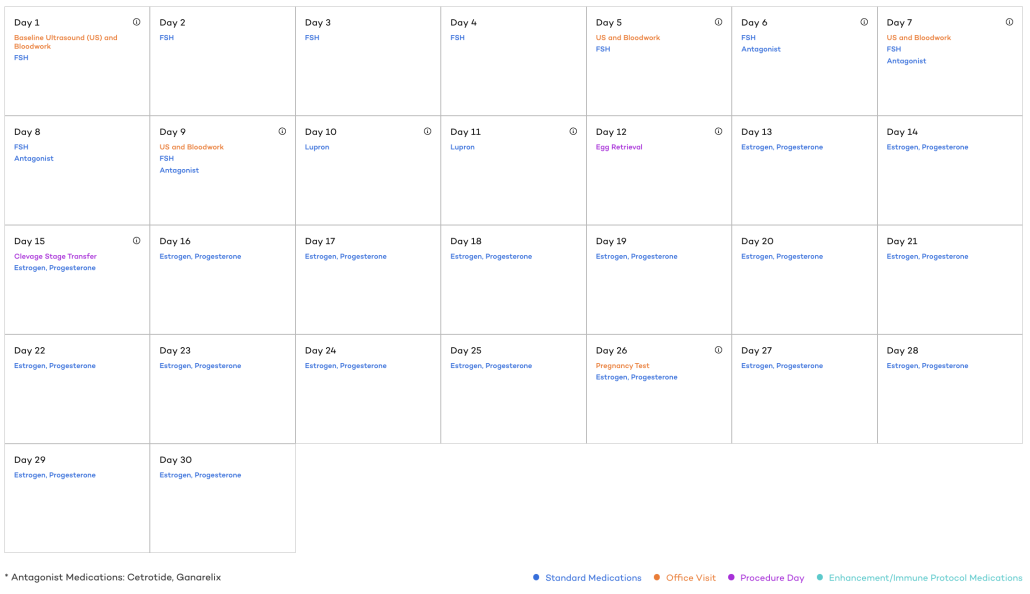Lupron with IVF: How it Works, Protocols, and Timelines

Lupron is an injectable medication used in IVF. Depending on the protocol, Lupron is used very differently.
This article will explore what Lupron is, how it works, how it is used in different IVF protocols, and why it will likely be used for your IVF treatment.
What Is Lupron?
Leuprolide acetate, known by the brand name Lupron, is a type of injectable fertility drug that falls under the category of GnRH agonists/analogue.
GnRH agonists are synthetic forms of the body’s endogenous Gonadotropin Releasing Hormone, with a few slight modifications that give them a stronger affinity to the GnRH receptors.
Leuprolide Acetate Mechanism: How Lupron Functions
Binding of the GnRH receptors causes the release of Follicle Stimulating Hormone (FSH) and Luteinizing Hormone (LH). However, only the initial binding of the molecule to the receptor causes the release of FSH and LH. Because Lupron and other GnRH analogs have a high affinity for the receptor, they do not let go and effectively block the receptor from firing and triggering the release of FSH and LH. This allows Lupron to function in two distinct ways in various IVF protocols.
That is, upon initial administration and binding of receptors, Lupron causes a temporary elevation of FSH, LH, and Testosterone – commonly called the flare. After all the receptors have been bound to and blocked by the “stickier” GnRH analog (Lupron), no new binding and firing of the receptors can take place. With no new receptors firing, the elevated levels of FSH and LH decrease and Lupron begins to have its suppressing effects.
In short, Lupron causes a temporary elevation in FSH and LH, followed by a long-term suppression of FSH and LH – so long as the medication is taken.
Depending on when, how much, and how Lupron is administered, it can either cause or delay/prevent ovulation. In the context of IVF, it can function to perform either.
How Does Lupron Work in IVF Protocols?
Lupron functions differently depending on the IVF protocol used. Here’s a summary of how Lupron is used in two common protocols.
Lupron as a Trigger Shot – The Antagonist Protocol (AKA short protocol)
The most common type of protocol in IVF is the antagonist protocol, which uses another class of medications called GnRH Antagonists (not agonists) like Cetrotide or Ganirellix to suppress/delay ovulation.
Because Cetrotide and Ganirelix’s suppressing effects take place immediately, the antagonist protocol is around 7-14 days shorter in time and requires less medications than the long protocol.
While Lupron is not used to suppress ovulation, it may be used as a trigger shot to assist in the final maturation of the eggs before the egg retrieval.
One of the benefits of using Lupron as a trigger shot is that it is particularly useful for populations at risk of OHSS. As an alternative to the Human Chorionic Gonadotropin (hCG) trigger shot, Lupron greatly reduces the chances of OHSS.
OHSS occurs when the ovaries become overstimulated, leading to potentially serious health risks. OHSS is a potential complication of any IVF treatment protocol and occurs in approximately 1-5% of cases. Though it is most common in young women with naturally higher numbers of follicles (or those with high AMH) and women with PCOS.
The good news is that using a Lupron trigger rather than an hCG trigger virtually eliminates the risk of OHSS. .
Unlike hCG, which can linger in the body for up to 10 days and exacerbate the risk of OHSS, a Lupron trigger shot stimulates a short, sharp surge of luteinizing hormone (LH) that is enough to mature the eggs without overstimulating the ovaries.
Lupron can also be used in conjunction with a low dose of hCG as the trigger as a way to balance the risk of OHSS while ensuring effective egg maturation.
Studies comparing the use of an hCG trigger, versus a dual trigger that combined hCG with a GnRH agonist (like Lupron) found that while the overall egg count and pregnancy rates were similar, the combination of an hCG and GnRH agonist trigger may result in better-quality embryos and more embryos available for freezing, making it a promising option for improving IVF outcomes.
Here’s a standard antagonist IVF calendar:

To Delay/Suppress Ovulation as a Component of the Down Regulation Protocol (Lupron protocol, Long protocol, Long Lupron, or Luteal Lupron Protocol)
Though less common than Antagonist IVF protocols, a down regulation protocol uses Lupron to “down-regulate” or suppress the pituitary gland’s normal production of hormones, essentially preventing/delaying ovulation.
In the down regulation protocol, Lupron is started on cycle day 21 and continued until the use of an HCG trigger. This typically makes the down regulation protocol a longer process than other protocols. .2
Here’s a standard down regulation IVF calendar:

Will my Provider Recommend Lupron?
If you’re undergoing IVF, there’s a good chance you will use Lupron.
Lupron is particularly recommended for women who are at a higher risk of developing OHSS. This includes younger females, those with a history of OHSS, women diagnosed with polycystic ovary syndrome (PCOS), or those who have been found to have a high follicle count during an ultrasound or AMH levels.
Lupron for IVF: The Takeaway
Lupron is an important fertility medication that plays various roles in most IVF cycles. Depending on how it is used, it can function as both a suppressor and/or trigger of ovulation.
For those at risk of OHSS, Lupron plays an especially important role as it triggers the final maturation of the eggs, similar to an hCG trigger, but with very little risk of OHSS.
By working closely with your fertility specialist, you can determine whether Lupron is the best choice for your IVF journey and how it will be used. Take your fertility journey into your own hands and schedule a consultation today.

